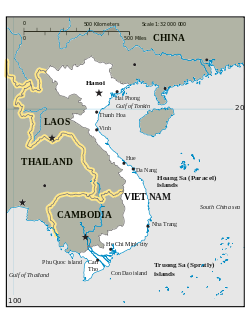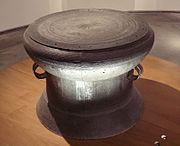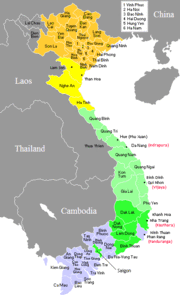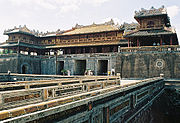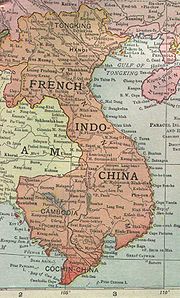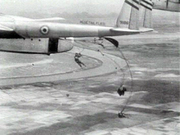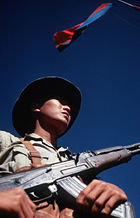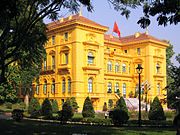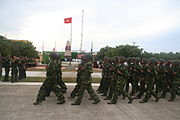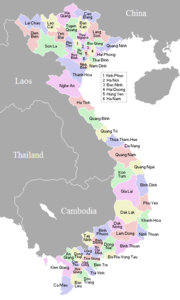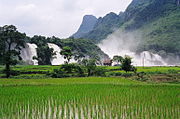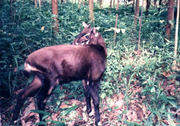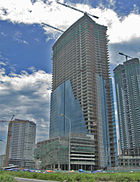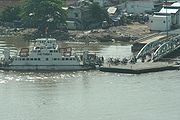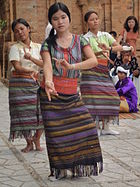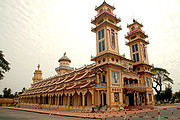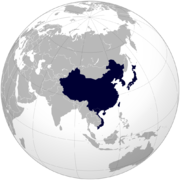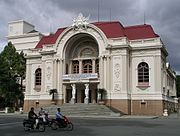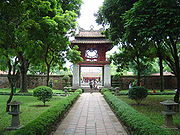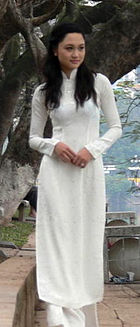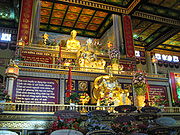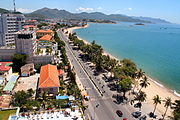
Vietnam
Background Information
SOS Children has tried to make Wikipedia content more accessible by this schools selection. See http://www.soschildren.org/sponsor-a-child to find out about child sponsorship.
| Socialist Republic of Vietnam Cộng hòa xã hội chủ nghĩa Việt Nam
|
||||||
|---|---|---|---|---|---|---|
|
||||||
| Motto: Độc lập - Tự do - Hạnh phúc "Independence - Freedom - Happiness" |
||||||
| Anthem: Tiến Quân Ca "Army March" (first verse) |
||||||
|
Location of Vietnam (green)
in ASEAN (dark grey) — [Legend] |
||||||
| Capital | Hanoi 21°2′N 105°51′E |
|||||
| Largest city | Ho Chi Minh City | |||||
| Official languages | Vietnamese | |||||
| Official scripts | Vietnamese alphabet | |||||
| Demonym | Vietnamese | |||||
| Government | Unitary socialist republic, Single-party state |
|||||
| - | President | Nguyễn Minh Triết | ||||
| - | Prime Minister | Nguyễn Tấn Dũng | ||||
| - | General Secretary of CPV | Nông Đức Mạnh | ||||
| - | Chairman of National Assembly of Vietnam | Nguyễn Phú Trọng | ||||
| Legislature | National Assembly of Vietnam | |||||
| Formation | ||||||
| - | Đại Việt | 1054 | ||||
| - | French annexation | 1853 to 1883 | ||||
| - | Independence from France | 2 September 1945 | ||||
| - | Reunification | 30 April 1975 | ||||
| - | Current constitution | 15 April 1992 | ||||
| Area | ||||||
| - | Total | 331,690 km2 ( 65th) 128,527 sq mi |
||||
| - | Water (%) | 1.3 | ||||
| Population | ||||||
| - | 1 April 2009 census | 85,846,997 ( 13th) | ||||
| - | Density | 259/km2 ( 46th) 668/sq mi |
||||
| GDP ( PPP) | 2009 estimate | |||||
| - | Total | $256.584 billion | ||||
| - | Per capita | $2,942 | ||||
| GDP (nominal) | 2010 estimate | |||||
| - | Total | $104,600 billion | ||||
| - | Per capita | $1,168 | ||||
| Gini (2002) | 37 medium · 59th |
|||||
| HDI (2010) | Error: Invalid HDI value · 113th |
|||||
| Currency | đồng (₫) ( VND) |
|||||
| Time zone | UTC+7 ( UTC+7) | |||||
| - | Summer ( DST) | No DST ( UTC+7) | ||||
| Drives on the | right | |||||
| Calling code | 84 | |||||
| ISO 3166 code | VN | |||||
| Internet TLD | .vn | |||||
|
|
||||||
| 1. | According to the official name and 1992 Constitution. | |||||
Vietnam (pronounced /ˌviː.ɛtˈnɑːm/ VEE-et-nahm; Vietnamese: Việt Nam, listen), officially the Socialist Republic of Vietnam ( Vietnamese: Cộng hòa xã hội chủ nghĩa Việt Nam, listen), is the easternmost country on the Indochina Peninsula in Southeast Asia. It is bordered by People's Republic of China (PRC) to the north, Laos to the northwest, Cambodia to the southwest, and the South China Sea, referred to as East Sea ( Vietnamese: Biển Đông), to the east. With a population of over 86 million, Vietnam is the 13th most populous country in the world.
The people of Vietnam regained independence and broke away from China in AD 938 after their victory at the battle of Bạch Đằng River. Successive dynasties flourished along with geographic and political expansion deeper into Southeast Asia, until it was colonized by the French in the mid-19th century. Efforts to resist the French eventually led to their expulsion from the country in the mid-20th century, leaving a nation divided politically into two countries. Fighting between the two sides continued during the Vietnam War, ending with a North Vietnamese victory in 1975.
Emerging from this prolonged military engagement, the war-ravaged nation was politically isolated. In 1986, the government instituted economic and political reforms and began a path towards international reintegration. By 2000, it had established diplomatic relations with most nations. Its economic growth has been among the highest in the world in the past decade. These economic reforms also introduced inequality in many spheres of life in Vietnam such as income distribution and women's rights.
Etymology
Việt Nam (Vietnamese pronunciation: [vjə̀tnam]) was adopted as the official name of the country by Emperor Gia Long in 1804. It is a variation of " Nam Việt" ( 南 越, Southern Việt), a name used in ancient times. In 1839, Emperor Minh Mạng renamed the country Đại Nam ("Great South"). In 1945, the nation's official name was changed back to "Vietnam". The name is also sometimes rendered as "Viet Nam" in English.
History
Pre-Dynastic era
The area now known as Vietnam has been inhabited since Paleolithic times, and some archaeological sites in Thanh Hóa Province purportedly date back several thousand years. Archaeologists link the beginnings of Vietnamese civilization to the late Neolithic, Early Bronze Age, Phung Nguyen culture, which was centered in Vĩnh Phúc Province of contemporary Vietnam from about 2000 to 1400 BCE.
By about 1200 BCE, the development of wet-rice cultivation and bronze casting in the Ma River and Red River plains led to the development of the Dong Son culture, notable for its elaborate bronze drums. The bronze weapons, tools, and drums of Dong-Sonian sites show a Southeast Asian influence that indicates an indigenous origin for the bronze-casting technology.
Many small, ancient copper mine sites have been found in northern Vietnam. Some of the similarities between the Dong-Sonian sites and other Southeast Asian sites include the presence of boat-shaped coffins and burial jars, stilt dwellings, and evidence of the customs of betel-nut-chewing and teeth-blackening.
Dynastic era
The legendary Hồng Bàng Dynasty of the Hùng kings is considered by many Vietnamese as the first Vietnamese state, known as Văn Lang. In 257 BCE, the last Hùng king lost to Thục Phán, who consolidated the Lạc Việt tribes with his Âu Việt tribes, forming Âu Lạc and proclaiming himself An Dương Vương. In 207 BCE, a Chinese general named Zhao Tuo defeated An Dương Vương and consolidated Âu Lạc into Nanyue. In 111 BCE, the Chinese Han Dynasty consolidated Nanyue into their empire.
For the next thousand years, Vietnam was mostly under Chinese rule. Early independence movements such as those of the Trưng Sisters and of Lady Triệu were only briefly successful. It was independent as Vạn Xuân under the Anterior Lý Dynasty between 544 and 602. By the early 10th century, Vietnam had gained autonomy, but not independence, under the Khúc family.
In 938 CE, a Vietnamese lord named Ngô Quyền defeated Chinese forces at the Bạch Đằng River and regained independence after a millennium under Chinese control. Renamed as Đại Việt (Great Viet), the nation went through a golden era during the Lý and Trần Dynasties. During the rule of the Trần Dynasty, Đại Việt repelled three Mongol invasions. Buddhism flourished and became the state religion.
Following the brief Hồ Dynasty, Vietnamese independence was momentarily interrupted by the Chinese Ming Dynasty, but was restored by Lê Lợi, the founder of the Lê Dynasty. Vietnam reached its zenith in the Lê Dynasty of the 15th century, especially during the reign of Emperor Lê Thánh Tông (1460–1497). Between the 11th and 18th centuries, Vietnam expanded southward in a process known as nam tiến ( southward expansion), and it eventually conquered the kingdom of Champa and part of the Khmer Empire.
From the 16th century onwards, civil strife and frequent infighting engulfed much of Vietnam. First, the Chinese-supported Mạc Dynasty challenged the Lê Dynasty's power. After the Mạc Dynasty was defeated, the Lê Dynasty was reinstalled, but with no actual power. Power was divided between the Trịnh Lords in the North and the Nguyễn Lords in the South, who engaged in a civil war for more than four decades before a truce was called in the 1670s. During this time, the Nguyễn expanded southern Vietnam into the Mekong Delta, annexing the Central Highlands and the Khmer land in the Mekong Delta.
The division of the country ended a century later when the Tây Sơn brothers defeated both and established their new dynasty. However, their rule did not last long and they were defeated by the remnants of the Nguyễn Lords led by Nguyễn Ánh with the help of the French. Nguyễn Ánh unified Vietnam, and established the Nguyễn Dynasty, ruling under the name Gia Long.
French colonisation
Vietnam's independence was gradually eroded by France—aided by large Catholic collaborator militias—in a series of military conquests from 1859 until 1885 when the entire country became part of French Indochina. The French administration imposed significant political and cultural changes on Vietnamese society. A Western-style system of modern education was developed, and Roman Catholicism was propagated widely in Vietnamese society. Most of the French settlers in Indochina were concentrated in Cochinchina (southern third of Vietnam whose principal city was Saigon).
Developing a plantation economy to promote the exports of tobacco, indigo, tea and coffee, the French largely ignored increasing calls for self-government and civil rights. A nationalist political movement soon emerged, with leaders such as Phan Boi Chau, Phan Chu Trinh, Phan Dinh Phung, Emperor Hàm Nghi and Ho Chi Minh fighting or calling for independence. However, the royalist Can Vuong was defeated in the 1890s after a decade of resistance, and the 1930 Yen Bai mutiny of the Viet Nam Quoc Dan Dang was put down easily. The French maintained control of their colonies until World War II, when the Japanese war in the Pacific triggered the invasion of French Indochina in 1941.
With the defeat of France in Europe, the French Third Republic transformed into the Vichy Regime, to which the colony remained loyal. Heavily dependent on Nazi Germany, Vichy France was forced to surrender control of French Indochina to Japan. The natural resources of Vietnam were exploited for the purposes of the Japanese Empire's military campaigns into the British Indochinese colonies of Burma, the Malay Peninsula and India.
First Indochina War
In 1941, the Viet Minh — a communist and nationalist liberation movement — emerged under Ho Chi Minh to seek independence for Vietnam from France as well as to oppose the Japanese occupation. An estimated 2 million Vietnamese, or 10% of the population then, died during the Vietnamese famine of 1944–45. Following the military defeat of Japan and the fall of its Empire of Vietnam in August 1945, Viet Minh occupied Hanoi and proclaimed a provisional government, which asserted independence on 2 September.
In the same year the Provisional French Republic sent the French Far East Expeditionary Corps, which was originally created to fight the Japanese occupation forces, in order to pacify the liberation movement and to restore French rule. On November 20, 1946, triggered by the Haiphong Incident, the First Indochina War between Viet Minh and the French forces ensued, lasting until July 20, 1954.
Despite fewer losses — Expeditionary Corps suffered one-third of the casualties of the Chinese and Soviet-backed Viet Minh — during the course of the war, the French and Vietnamese loyalists eventually suffered a major strategic setback at the Siege of Dien Bien Phu, which allowed Ho Chi Minh to negotiate a ceasefire with a favorable position at the ongoing Geneva conference of 1954. Colonial administration ended as French Indochina was dissolved. According to the Geneva Accords of 1954 the forces of former French supporters and communist nationalists were separated south and north, respectively, with the Vietnamese Demilitarized Zone, at the 17th parallel north, between. A 300-day period of free movement was given, during which almost a million northerners, mainly Catholic, moved south, fearing persecution by the communists.
A partition of Vietnam, with Ho Chi Minh's Democratic Republic of Vietnam in North Vietnam, and Emperor Bảo Đại's State of Vietnam in the South Vietnam, was not intended to be permanent by the Geneva Accords, and they expressly forbade the interference of third powers. The State of Vietnam's Prime Minister Ngo Dinh Diem toppled Bảo Đại in a fraudulent referendum organised by his brother Ngo Dinh Nhu, and proclaimed himself president of the Republic of Vietnam. The Accords mandated nationwide elections by 1956, which Diem refused to hold, despite repeated calls from the North for talks to discuss elections.
Vietnam War
The pro-Hanoi Vietcong began a guerrilla campaign in the late 1950s to overthrow Diem's government, which an official Vietcong statement described as a "disguised colonial regime." In the North, thousands of landowners were murdered by the communists and famine broke out in the 1950s. In the South, Diem went about crushing all opposition and tens of thousands were jailed or killed; dissidents were routinely labelled as communists even if they were anti-communist. Both Vietnams were police states with totalitarian security systems.
In 1963, Buddhist discontent with Diem's pro-Catholic discrimination erupted following the banning of the Buddhist flag and the Hue Vesak shootings. This resulted in a series of mass demonstrations during what is known as the Buddhist crisis. With Diem unwilling to bend, Nhu orchestrated the Xa Loi Pagoda raids; estimates of the death toll range into the hundreds. As a result, America's relationship with Diem broke down and resulted in a coup that saw Diem killed.
Diem was followed by a series of military regimes that often lasted only months before being toppled by another. With this instability, the communists began to gain ground. There were more than a dozen governments before the pairing of Air Marshal Nguyen Cao Ky and General Nguyễn Văn Thiệu took control of a junta in mid-1965. Thieu gradually outmaneuvered Ky and cemented his grip on power in fraudulent elections in 1967 and 1971.
To support South Vietnam's struggle against the communist insurgency, the United States began increasing its contribution of military advisers. US forces became embroiled in ground combat operations in 1965 and at their peak they numbered more than 500,000. Communist forces attacked most major targets in South Vietnam during the 1968 Tet Offensive, and although their campaign failed militarily, it shocked the American establishment, and caused them to think that the communists could not be defeated. Communist forces supplying the Vietcong carried supplies along the Ho Chi Minh trail, which passed through Laos and Cambodia. US president Richard Nixon authorized Operation Menu, an SAC bombing campaign in Laos and Cambodia, which he kept secret from the US Congress.
Its own casualties mounting, and facing opposition to the war at home and condemnation abroad, the U.S. began withdrawing from ground combat roles according to the Nixon Doctrine; the process was subsequently called Vietnamization. The effort had mixed results. The Paris Peace Accords of 27 January 1973, formally recognized the sovereignty of Vietnam "as recognized by the 1954 Geneva Agreements." Under the terms of the accords all American combat troops were withdrawn by 29 March 1973. Limited fighting continued, before the north captured the province of Phuoc Long in December 1974 and started a full-scale offensive, culminating in the Fall of Saigon on 30 April 1975. South Vietnam briefly came under the nominal rule of a Provisional Revolutionary Government while under military occupation by North Vietnam. On 2 July 1976, North and South were merged to form the Socialist Republic of Vietnam.
Postwar period
The government embarked on a mass campaign of collectivization of farms and factories. This caused an economic collapse and resulted in triple-digit inflation. Reconstruction of the war-ravaged country was slow, and serious humanitarian and economic problems confronted the communist regime. Millions of people fled the country in crudely built boats, creating an international humanitarian crisis.
In 1978, the Vietnamese army invaded Cambodia (sparking the Cambodian-Vietnamese War) to remove from power the Khmer Rouge—who had been razing Vietnamese border villages and massacring the inhabitants, installing a regime whose leaders rule until 1989. This action worsened relations with China, which launched a brief incursion into northern Vietnam (the Sino-Vietnamese War) in 1979. This conflict caused Vietnam to rely even more heavily on Soviet economic and military aid.
Đổi Mới (renovation)
At the Sixth Congress of the Communist Party of Vietnam in December 1986, reformers, upset by the lack of economic progress after the Vietnam War, replaced the "old guard" with new leadership. The reformers were led by 71 year-old Nguyen Van Linh, who became the party's new general secretary. Linh was a native of northern Vietnam who had served in the south both during and after the war. In a historic shift, the reformers implemented free-market reforms known as Đổi Mới (renovation), which carefully managed the transition from a planned economy to a " socialist-oriented market economy".
With the authority of the state remaining unchallenged, private ownership of farms and companies engaged in commodity production, deregulation and foreign investment were encouraged while the state maintained control over strategic industries. The economy of Vietnam subsequently achieved rapid growth in agricultural and industrial production, construction and housing, exports and foreign investment. However, these reforms have also caused a rise in inequalities in many spheres of social life, such as income and gender inequality.
Government and politics
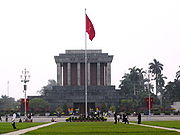
The Socialist Republic of Vietnam is a single-party state. A new state constitution was approved in April 1992, replacing the 1975 version. The central role of the Communist Party of Vietnam was reasserted in all organs of government, politics and society.
Only political organizations affiliated with or endorsed by the Communist Party are permitted to contest elections. These include the Vietnamese Fatherland Front, worker and trade unionist parties. Although the state remains officially committed to socialism as its defining creed it is increasingly capitalist, according to The Economist it is currently run by "ardently capitalist communists".
The President of Vietnam is the titular head of state and the nominal commander in chief of the military of Vietnam, chairing the Council on National Defense and Security. The current Prime Minister of Vietnam, Nguyen Tan Dung, is the head of government, presiding over a council of ministers composed of three deputy prime ministers and the heads of 26 ministries and commissions.
The National Assembly of Vietnam is the unicameral legislature of the government, composed of 498 members. It is superior to both the executive and judicial branches. All members of the council of ministers are derived from the National Assembly. The Supreme People's Court of Vietnam, which is the highest court of appeal in the nation, is also answerable to the National Assembly.
Beneath the Supreme People's Court stand the provincial municipal courts and the local courts. Military courts are also a powerful branch of the judiciary with special jurisdiction in matters of national security. All organs of Vietnam's government are controlled by the Communist Party. Most government appointees are members of the party. The General Secretary of the Communist Party is perhaps one of the most important political leaders in the nation, controlling the party's national organization and state appointments, as well as setting policy.
The Vietnam People's Army (VPA) is the official name for the combined military services of Vietnam, which is organized along the lines of China's People's Liberation Army. The VPA is further subdivided into the Vietnamese People's Ground Forces (including Strategic Rear Forces and Border Defense Forces), the Vietnam People's Navy, the Vietnam People's Air Force and the Vietnamese People's Coast Guard.
Through Vietnam's recent history, the VPA has actively been involved in Vietnam's workforce to develop the economy of Vietnam, in order to coordinate national defense and the economy. The VPA is involved in such areas as industry, agriculture, forestry, fishery and telecommunications. The total strength of the VPA is close to 500,000 officers and enlisted members. The government also organizes and maintains provincial militias and police forces. The role of the military in public life has steadily been reduced since the 1980s.
Human rights
In its 2004 report on Human Rights Practices, the U.S. Department of State characterized Vietnam's human rights record as "poor" and cited the continuation of "serious abuses". According to the report, the government has imposed restrictions on freedom of speech, freedom of the press, freedom of assembly, and freedom of association.
International relations
The current Vietnamese foreign policy is: "Implement consistently the foreign policy line of independence, self-reliance, peace, cooperation and development; the foreign policy of openness and diversification and multi-lateralization of international relations. Proactively and actively engage in international economic integration while expanding international cooperation in other fields. Vietnam is a friend and reliable partner of all countries in the international community, actively taking part in international and regional cooperation processes."
As of December 2007, Vietnam had established diplomatic relations with 172 countries (including the United States, which normalized relations in 1995). Vietnam holds membership of 63 international organizations such as the United Nations, ASEAN, NAM, La Francophonie, WTO and 650 non-government organizations.
Geography
Location
 |
 |
|||
| South China Sea | ||||
| South China Sea | South China Sea |
Subdivisions
Vietnam is divided into 58 provinces (known in Vietnamese as tỉnh, from the Chinese 省, shěng). There are also 5 centrally controlled municipalities existing at the same level as provinces (thành phố trực thuộc trung ương).
|
Red River Delta
Bắc Ninh |
North Central Coast
Ha Tinh |
Northeast
Bắc Giang |
Northwest
Dien Bien |
|
Central Highlands
Dak Lak |
South Central Coast
Binh Dinh |
Southeast
Ba Ria-Vung Tau |
Mekong River Delta
An Giang |
The provinces are further subdivided into provincial municipalities (thành phố trực thuộc tỉnh), townships (thị xã) and counties (huyện), and then, subdivided into towns (thị trấn) or communes (xã).
The centrally controlled municipalities are subdivided into districts (quận) and counties, and then, subdivided into wards (phường).
Geography and climate
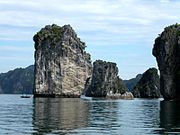
Vietnam is approximately 331,688 km2 (128,065 sq mi) in area (not including Hoang Sa and Truong Sa islands), larger than Italy and almost the size of Germany. The perimeter of the country running along its international boundaries is 4,639 km2 (1,791 sq mi). The topography consists of hills and densely forested mountains, with level land covering no more than 20%. Mountains account for 40% of the area, with smaller hills accounting for 40% and tropical forests 42%.
The northern part of the country consists mostly of highlands and the Red River Delta. Phan Xi Păng, located in Lào Cai province, is the highest mountain in Vietnam at 3,143 m (10,312 ft). The south is divided into coastal lowlands, Annamite Chain peaks, extensive forests, and poor soil. Comprising five relatively flat plateaus of basalt soil, the highlands account for 16% of the country's arable land and 22% of its total forested land.
The delta of the Red River (also known as the Sông Hồng), a flat, triangular region of 15,000 km2 (5,792 sq mi), is smaller but more intensely developed and more densely populated than the Mekong River Delta. Once an inlet of the Gulf of Tonkin, it has been filled in by the enormous alluvial deposits of the rivers over a period of millennia, and it advances one 100 meters (328.1 ft) into the Gulf annually. The Mekong delta, covering about 40,000 km2 (15,444 sq mi), is a low-level plain no more than 3 meters (9.8 ft) above sea level at any point and criss-crossed by a maze of canals and rivers. So much sediment is carried by the Mekong's various branches and tributaries that the delta advances 60 to 80 meters (196.9 to 262.5 ft) into the sea every year.
Because of differences in latitude and the marked variety of topographical relief, the climate tends to vary considerably from place to place. During the winter or dry season, extending roughly from November to April, the monsoon winds usually blow from the northeast along the China coast and across the Gulf of Tonkin, picking up considerable moisture; consequently the winter season in most parts of the country is dry only by comparison with the rainy or summer season.
The average annual temperature is generally higher in the plains than in the mountains and plateaus and in the south than in the north. Temperatures in the southern plains (Ho Chi Minh City and the Mekong Delta) varies less, going between 21 and 28 °C (69.8 and 82.4 °F) over the course of a year. The seasons in the mountains and plateaus and in the north are much more dramatic, and temperatures may vary from 5 °C (41 °F) in December and January to 37 °C (98.6 °F) in July and August.
Nature
Vietnam has two World Natural Heritage sites: Halong Bay and Phong Nha-Ke Bang National Park and six World biosphere reserves including: Can Gio Mangrove Forest, Cat Tien, Cat Ba, Kien Giang, Red River Delta, Western Nghe An. Because of Typhoon Ketsana of 29 September 2009, more than 300,000 persons were evacuated.
Biodiversity
Vietnam is in the Indomalaya ecozone.
According to chapter 1 of the 2005 National Environmental Present Condition Report, "Biodiversity Subject of Vietnam Environment Protection Agency," in terms of species diversity Vietnam is one of twenty five countries considered to possess a high level of biodiversity, and is ranked 16th in biological diversity (having 16% world's species) (page 9). 15,986 flora were identified, of which 10% are endemic (p9). Statistics indicate that there are 307 nematodes, 200 oligochaeta, 145 acarina, 113 springtails, 7750 insects, 260 reptiles, 120 amphibians, 840 birds and 310 mammals of which 100 birds and 78 mammals are endemic (p9,10).
Vietnam also has 1438 fresh water microalgae (9,6% species in the world) (Table 1.2, p9). It is also noted that there are 794 aquatic invertebrates and 2458 sea fish (p10,11). In recent years, there have been 13 genera, 222 species, and 30 taxa of flora newly described. 6 mammals have been discovered including the saola, giant muntjac, Tonkin Snub-nosed Langur, livistona halongensis, geothelphusa vietnamica, and 1 bird, the Edwards's Pheasant.
In agricultural genetic diversity, Vietnam is one of the world's twelve original cultivar centers (p13). The Vietnam National Cultivar Gene Bank is preserving 12,300 cultivars of 115 species (p14). In Chapter 4 of that report, it is said that the Vietnamese government spent 49.07 million USD for preserving biodiversity in 2004 (p71) and has established 126 conservation areas including 28 national parks (p73).
Economy and foreign relations
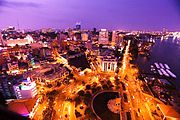
Historically, Vietnam has been an agricultural civilization based on wet rice cultivating. The Vietnam War destroyed much of the country's economy. Upon taking power, the Government created a planned economy for the nation.
Collectivization of farms, factories and economic capital was implemented, and millions of people were put to work in government programs. For a decade, united Vietnam's economy was plagued with inefficiency and corruption in state programs, poor quality and underproduction and restrictions on economic activities and trade. It also suffered from the trade embargo from the United States and most of Europe after the Vietnam War. Subsequently, the trade partners of the Communist blocs began to erode.
In 1986, the Sixth Party Congress introduced significant economic reforms with free market economy elements as part of a broad economic reform package called " đổi mới" (Renovation), resulting in a Socialist-oriented market economy. Private ownership was encouraged in industries, commerce and agriculture.
Vietnam achieved around 8% annual GDP growth from 1990 to 1997 and continued at around 7% from 2000 to 2005, making it one of the world's fastest growing economies. Growth by 8.5 percent, 6.3, 5.3 and 6.8 for the year of 2007, 2008, 2009 and 2010 respectively, but inflation rate hit 11.8 percent in December 2010 on a year-on-year basis, according to a GSO estimate. The dong has been devalued three times since late last year. Before 1998, foreign investment grew threefold and domestic savings quintupled. Manufacturing, information technology and high-tech industries form a large and fast-growing part of the national economy. Vietnam is a relative newcomer to the oil business, but today it is the third-largest oil producer in Southeast Asia with output of 400,000 barrels per day (64,000 m3/d). Vietnam is one of Asia's most open economies: two-way trade is around 160% of GDP, more than twice the ratio for China and over four times India's.
Deep poverty, defined as a percent of the population living under $1 per day, has declined significantly and is now smaller than that of China, India, and the Philippines.
In 2009, the nominal GDP reached $92.439 billion, with nominal GDP per capita of $1,060 According to a forecast in December 2005 by Goldman-Sachs, Vietnamese economy will become the 17th largest economy in the world in 2025, with nominal GDP of $ 436 billion and GDP per capita of 4,357 USD. According to the forecast by the PricewaterhouseCoopers in 2008, Vietnam may be fastest growing of emerging economies by 2025 with a potential growth rate of almost 10% per annum in real dollar terms that could push it up to around 70% of the size of the UK economy by 2050.
As a result of several land reform measures, Vietnam is now the largest producer of cashew nuts with a one-third global share, the largest producer of black pepper accounting for one-third of the world's market and second largest rice exporter in the world after Thailand. Vietnam has the highest percent of land use for permanent crops, 6.93%, of any nation in the Greater Mekong Subregion. Besides rice, key exports are coffee, tea, rubber, and fishery products. However, agriculture's share of economic output has declined, falling as a share of GDP from 42% in 1989 to 20% in 2006, as production in other sectors of the economy has risen. According to the CIA World Fact Book, the unemployment rate in Vietnam is 2.9% (30 April 2009 est.)
Among other steps taken in the process of transitioning to a market economy, Vietnam in July 2006 updated its intellectual property legislation to comply with TRIPS. Vietnam was accepted into the WTO on November 7, 2006. Vietnam's chief trading partners include China, Japan, Australia, ASEAN countries, the U.S. and Western European countries. Vietnam still uses five-year plans however (see Five-Year Plans of Vietnam).
Transport
Air
Vietnam operates 17 major civil airports, including three international gateways: Noi Bai serving Hanoi, Da Nang International Airport serving Da Nang City, and Tan Son Nhat serving Ho Chi Minh City. Tan Son Nhat is the largest, handling 75 percent of international passenger traffic. According to the approved plan, Vietnam will have 10 international airports by 2015 (besides the three above-mentioned airport, they are: Lien Khuong International Airport, Phu Bai International Airport, Cam Ranh International Airport, Phu Quoc International Airport, Cat Bi International Airport, Cần Thơ International Airport and Long Thanh International Airport). The planned Long Thanh International Airport will be built on an area of 50 square kilometres (19 sq mi) and will have full capacity of 100 million passengers, 5 metric tons of cargo per annum. Vietnam Airlines, the national airline, has a fleet of 69 (150 in 2020) aircraft A number of private airlines that supplement the state-owned Vietnam Airlines are Jetstar Pacific, VietJet AirAsia and Trai Thien Air Cargo.
The modern transport network of Vietnam was originally developed under French rule for the purpose of raw materials harvesting, and reconstructed and extensively modernized following the Vietnam War. The road system is the most popular form of transportation in the country. Vietnam's road system includes national roads administered by the central level; provincial roads managed by the provincial level; district roads managed by the district level; urban roads managed by cities and towns; and commune roads managed by the commune level.
Road
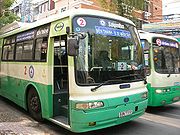
Bicycles, motor scooters and motorcycles remain the most popular forms of road transport in Vietnam's cities, towns, and villages although the number of privately owned automobiles is also on the rise, especially in the larger cities. Public bus operated by private companies is the main long distance travel means for many people. Traffic congestion is a serious problem in Hanoi and Ho Chi Minh City as the cities' roads struggle to cope with the booming numbers of automobiles.
Rail
In 2009, Vietnam and Japan signed a deal to build a high-speed railway using Japanese technology. Vietnamese high speed engineers were sent to Japan to take a high-speed course from March to November. Since 2006, Vietnam has sent 100 high-speed operators to take courses in Japan so they can operate it once it is completed. The railway will be a 1,630-km-long express route and contain a total of 26 stations, including Hanoi and Thu Thiem terminus in Ho Chi Minh City. It will help reduce the travel time between the country's two largest cities to under 10 hours.
Using the planned technology ( Shinkansen), the railway will be designed for trains to travel at a maximum speed of 360 km per hour. However, the consultant joint venture recommended running trains at a maximum of 320 km per hour using Fastech 360s trains. As scheduled, the railway lines from Hanoi to central Vinh and from central Nha Trang to Ho Chi Minh City in southern Vietnam will be laid during the 2010-2015 period. From 2015-2020, construction will begin on the routes between Vinh and Nha Trang and between Hanoi and the northern mountainous provinces of Lao Cai and Lang Son.
Water
The nation has seven developed ports and harbors at Cam Ranh, Da Nang, Hai Phong, Ho Chi Minh City, Hong Gai (Halong City), Qui Nhơn, and Nha Trang. There are also more than 17,000 km of navigable waterways, which play a significant role in rural life owing to the extensive network of rivers in Vietnam.
Demographics
Population
The result of Census April 1, 2009 shows the population of Vietnam more than 85.8 million. Vietnamese people, of which: the so-called "Viet" or "Kinh" is nearly 73,6 million, account for 85.8% of the population. Their population is concentrated in the alluvial deltas and coastal plains of the country. A homogeneous social and ethnic group, the Kinh exert political and economic control. There are 54 ethnic minority groups throughout the country, but the Kinh are purveyors of the dominant culture.
Most ethnic minorities, such as the Muong, a closely related ethnic of the Kinh, are found mostly in the highlands covering two-thirds of the territory. Before the Vietnam War, the population of the Central Highlands was almost exclusively Degar (over 40 hill tribal groups), until Diem's governments enacted a program of settling Kinh in indigenous areas. The Hoa (ethnic Chinese) and Khmer Krom are mainly lowlanders. The largest ethnic minority groups include the Hmong, Dao, Tay, Thai, and Nung. From 1978 to 1979, some 450,000 ethnic Chinese left Vietnam.
Languages
The people of Vietnam speak Vietnamese which is a tonal monosyllabic Mon- Khmer language as an official national language. In its early history, Vietnamese writing used Chinese characters. In the 13th century, the Vietnamese developed their own set of characters called Chữ nôm. The celebrated epic Đoạn trường tân thanh (Truyện Kiều or The Tale of Kieu) by Nguyễn Du was written in Chữ nôm. During the French colonial period, Quốc ngữ, the romanized Vietnamese alphabet used for spoken Vietnamese, which was developed in 17th century by Jesuit Alexandre De Rhodes and several other Catholic missionaries, became popular and brought literacy to the masses.
Various other languages are spoken by several minority groups in Vietnam. The most common of these are Tày, Mường, Cham, Khmer, Chinese, Nùng, and H'Mông. The Montagnard peoples of the Central Highlands also speak a number of distinct languages. The French language, a legacy of colonial rule, is still spoken by some older Vietnamese as a second language, but is losing its popularity. Vietnam nevertheless remains a full member of La Francophonie. Russian — and to a much lesser extent German, Czech or Polish — is sometimes known among those whose families had ties with the Soviet bloc. In recent years, English is becoming more popular as a second language. English study is obligatory in most schools. Chinese and Japanese have also become more popular.
Religions
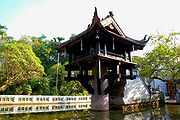
For much of Vietnamese history, Mahayana Buddhism, Taoism and Confucianism have strongly influenced the religious and cultural life of the people. About 85% of Vietnamese identify with Buddhism, though not all practice on a regular basis. Most people ascribe to Tam Đạo ("Triple religion"): 80% of people worship the mixture of Mahayana Buddhism mainly, Taoism, Confucianism with Ancestor Worship; 2% Hòa Hảo (a new 20th century religious movement that is concentrated in the Mekong Delta) and 2% Theravada Buddhism, mainly among Khmer people in the Mekong. The census of Government showed that only over 10 million people have taken refuge in the Three Jewels; the vast majority of Vietnamese people of Asian religions practice Ancestor Worship.
About 8% of the population are Christians, with about six million Roman Catholics and fewer than one million Protestants, according to the census of 2007. Christianity was introduced first by the Portuguese and the Dutch traders in the 16th and 17th centuries, then further propagated by French missionaries in the 19th and 20th centuries, and to a lesser extent, by American Protestant missionaries during the presence of American forces during the 1960s and early 1970s, largely among the Montagnards of South Vietnam. The largest Protestant churches are the Evangelical Church of Vietnam and the Montagnard Evangelical Church. Two thirds of Vietnam's Protestants are ethnic minorities.
The Vietnamese government is deeply suspicious and wary of Roman Catholicism. This mistrust originated during the 19th century when some Catholics collaborated with the French colonists in conquering and ruling the country and in helping French attempts to install Catholic emperors, such as in the Lê Văn Khôi revolt. Furthermore, the Catholic Church's strongly anti-communist stance has made it an a government enemy. The Vatican Church is banned and only government-controlled Catholic organisations are permitted. The country's relations with the Vatican have improved, however, in recent years.
About 3% of the population are Cao Dai, a syncretic 20th century religion that is concentrated around Tay Ninh Province.
Sunni and Cham Bani Islam, a small minority faith, is primarily practiced by the ethnic Cham minority, though there are also a few ethnic Vietnamese adherents in the southwest. In total there are 70,000 Muslims; small Hindu communities (over 50,000 people) and a small number of Baha'is.
The communist government rejects criticism that it does not allow religious freedom. Nevertheless, only government-controlled religious organisations are allowed and the Unified Buddhist Congregation of Vietnam that formed in South Vietnam is banned in favour of the communist-approved body.
Education
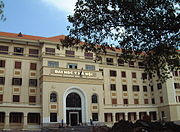
Vietnam has an extensive state-controlled network of schools, colleges and universities but the number of privately run and mixed public and private institutions is also growing. General education in Vietnam is imparted in 5 categories: Kindergarten, elementary schools, middle schools, high schools, and college/university. Courses are taught mainly in Vietnamese. A large number of public schools have been organized across the country to raise the national literacy rate, which was 90.3% between 2003 and 2008. There are a large number of specialist colleges, established to develop a diverse and skilled national workforce.
A large number of Vietnam's most acclaimed universities are based in Hanoi and Ho Chi Minh City. Facing serious crises, Vietnam's education system is under a holistic reform launched by the government. In Vietnam, education from age 6 to 11 is free and mandatory. Education above these ages is not free; therefore, some poor families may have trouble paying tuition for their children without some forms of public or private assistance. Regardless, school enrollment is among the highest in the world and the number of colleges and universities increased dramatically in recent years, from 178 in 2000 to 299 in 2005.
Health
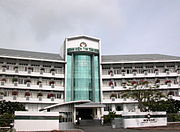
The overall quality of health in Vietnam is regarded as good, as of 2009 life expectancy is 76 for women and 72 for men. Infant mortality is 12 per 1,000 live births. However, malnutrition is still common in the provinces. In 2001, government spending on health care corresponded to just 0.9% of gross domestic product (GDP). Government subsidies covered only about 20% of health care expenses, with the remaining 80% coming out of individuals’ own pockets.
In 1954, North Vietnam established a public health system that reached down to the hamlet level. After the reunification in 1975, this system was extended to the former South Vietnam. Beginning in the late 1980s, the quality of health care began to decline as a result of budgetary constraints, a shift of responsibility to the provinces, and the introduction of charges. As of 2009 85% of the population has access to improved water sources. Inadequate funding also has contributed to a shortage of nurses, midwives, and hospital beds. In 2000 Vietnam had only 250,000 hospital beds, or 14.8 beds per 10,000 people, a very low ratio among Asian nations, according to the World Bank.
Vietnam has made progress in combating malaria, for which the mortality rate declined sharply, to about 5% of the rate in the early 1990s, after the country introduced antimalarial drugs and treatment. However, tuberculosis (TB) cases are on the rise, with 57 deaths per day reported in May 2004. With an intensified vaccination program, better hygiene, and foreign assistance, Vietnam hopes to reduce sharply the number of TB cases and annual new TB infections.
As of September 2005, Vietnam had diagnosed 101,291 HIV cases, of which 16,528 progressed to AIDS and 9,554 died. But the actual number of HIV-positive individuals is estimated to be much higher. An average, 40–50 new infections are reported every day in Vietnam. As of 2007 0.5% of the population is infected with HIV and the figure has been stable since 2005. In June 2004, the Bush Administration announced that Vietnam would be one of 15 nations to receive funding as part of a US$15 billion global AIDS plan.
Science and technology
Historically, Vietnamese scholars did not practice "science" in its generally accepted meaning, but many academic fields were well-developed, especially social sciences and humanities. It has at least ten centuries of commentary and analytic writings. Among the best known works are those of " Đại Việt sử ký toàn thư" - of Ngô Sĩ Liên. Writings that deal with geography, nature, customs and people were also written such as "Dư địa chí" by Nguyễn Trãi. In philosophy, Vietnamese monks led by abdicated Emperor Tran Nhan Tong developed Trúc Lâm Zen branch. In mathematics, arithmetics and geometry has been taught in schools since the 15th century, using the famous textbook: "Đại thành toán pháp" by Lương Thế Vinh. Lương Thế Vinh also introduced the notion of zero while Mạc Hiển Tích had used the term "số ẩn" (unknown/secret/hidden number) to refer to negative numbers even earlier. In the later centuries, much knowledge was collected into encyclopedias such as "Vân đài loại ngữ" by Lê Quý Đôn and "Lịch triều hiến chương loại chí" by Phan Huy Chú.
Recently, Vietnam's mathematical field has advanced human knowledge by several contributions, including the foundation of global optimization by Hoàng Tụy and the proof of fundamental lemma in the theory of automorphic forms by Ngô Bảo Châu (Fields Medal 2010).
Culture
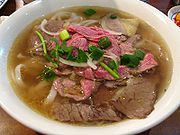
Vietnam is an agricultural civilization based on wet rice cultivation with ancient Dong Son culture as one of its defining aspects. The major stimulation of Vietnamese culture's development comes from indigenous factors, with Chinese serving to further enrich it. Through history, Cham culture and the cultures of other minority ethnic groups in Vietnam have been integrated with Vietnamese culture in correlated effects.
The official spoken and written language of Vietnam is Vietnamese.
Vietnam is considered a part of the East Asian Cultural Sphere, or Sinosphere, due to highly significant cultural influences from China throughout its history.
In the socialist era, the cultural life of Vietnam has been deeply influenced by government-controlled media and the cultural influences of socialist programs. For many decades, foreign cultural influences were shunned and emphasis placed on appreciating and sharing the culture of communist nations such as the Soviet Union, China, Cuba and others. Since the 1990s, Vietnam has seen a greater exposure to Southeast Asian, European and American culture and media.
Clothing
One of the most popular Vietnamese traditional garments is the " Áo Dài", worn often for special occasions such as weddings or festivals. White Áo dài is the required uniform for girls in many high schools across Vietnam. Áo Dài was once worn by both genders but today it is worn mainly by females, except for certain important traditional culture-related occasions where some men do wear it.
Cuisine
Vietnamese cuisine uses very little oil and many vegetables. The main dishes are often based on rice, soy sauce, and fish sauce. Its characteristic flavours are sweet (sugar), spicy ( serrano peppers), sour (lime), nuoc mam (fish sauce), and flavored by a variety of mint and basil.
Music
Vietnamese music varies slightly in the three regions: Bắc or North, Trung or Central, and Nam or South. Northern classical music is Vietnam's oldest and is traditionally more formal. Vietnamese classical music can be traced to the Mongol invasions, when the Vietnamese captured a Chinese opera troupe. Central classical music shows the influences of Champa culture with its melancholic melodies.
Literature
Vietnamese literature has a long history. Folk literature has been developed for centuries with many great arts, including a typical 6-8 verse poem kind named "ca dao", a system of tales about village establishers and heroes which served as cultural base for many cultural regions (for example, "Saint Gióng tales"). Written literatures dates from Ngô Dynasty with some admirable artists like Nguyễn Trãi with " Bình Ngô đại cáo", Trần Hưng Đạo with " Hịch tướng sĩ", Nguyễn Du with "Truyện Kiều" (English: The Tale of Kieu) and Nguyễn Đình Chiểu with " Lục Vân Tiên". Some genres play an important role in performance like "hát nói" in ca trù. Some poet unions have been formed like "Tao Đàn." The mordenization of literature has happened since Western cultural effect began in 19th century. The first transformation movement was "Thơ Mới" from 1932 to 1945.
Arts and sports
Vovinam and Bình Ðịnh martial arts are two popular Vietnamese martial arts practiced by many within Vietnam. Football (soccer) is the most popular team sport in Vietnam. Sports and games such as badminton, tennis, ping pong, and chess are also popular with large segments of the population. Volleyball, especially women's volleyball, is watched by a fairly large number of Vietnamese people. The (expatriate Vietnamese) community forms a prominent part of Vietnamese cultural life, introducing Western sports, films, music and other cultural activities in the nation.
Weddings
Among countless other traditional Vietnamese occasions, the traditional Vietnamese wedding is one of the most important. Many of the age-old customs in a Vietnamese wedding continue to be celebrated by both Vietnamese in Vietnam and overseas, often combining both western and eastern elements.
Tourism
Vietnam's number of visitors for tourism and vacation has increased steadily over the past ten years. About 3.77 million international guests visited Vietnam in 2009. The government and private enterprizes are investing capital into the coastal regions that are already popular for their beaches and boat tours.
Other documents
- Herring, George C. America's Longest War: The United States and Vietnam, 1950-1975 (4th ed 2001), most widely used short history.
- Jahn GC. 2006. The Dream is not yet over. In: P. Fredenburg P, Hill B, editors. Sharing rice for peace and prosperity in the Greater Mekong Subregion. Victoria, (Australia): Sid Harta Publishers. p 237-240
- Karrnow, Stanley. Vietnam: A History. Penguin (Non-Classics); 2nd edition (June 1, 1997). ISBN 0-14-026547-3
- McMahon, Robert J. Major Problems in the History of the Vietnam War: Documents and Essays (1995) textbook
- Oxford Advanced Learner's Dictionary, 7th edition, Oxford University Press.
- Tucker, Spencer. ed. Encyclopedia of the Vietnam War (1998) 3 vol. reference set; also one-volume abridgment (2001)


![Location of Vietnam (green)in ASEAN (dark grey) — [Legend]](../../images/941/94122.png)
